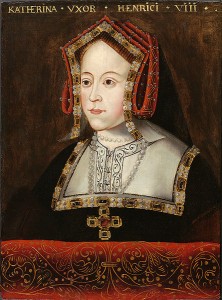 On this day in 1536, Catherine of Aragon died at her home, Kimbolton Hall, after being taken ill at the end of December. When Henry VIII was informed of his former wife’s illness, he allowed the Imperial ambassador, Eustace Chapuys, to visit her and he arrived at Catherine’s bedside on the 2nd January.
On this day in 1536, Catherine of Aragon died at her home, Kimbolton Hall, after being taken ill at the end of December. When Henry VIII was informed of his former wife’s illness, he allowed the Imperial ambassador, Eustace Chapuys, to visit her and he arrived at Catherine’s bedside on the 2nd January.
The Catherine of Aragon that Chapuys found on his arrival was a far different Catherine to the strong Queen that he had once known. She was seriously ill, in constant pain and was having trouble eating and sleeping. She was able to talk though and Linda Porter (in “Mary Tudor: The First Queen”) writes of how the two of them reminisced about the past and “she wondered aloud whether the course of action she had followed was the right one”, after all, she and her daughter had suffered so much.
Catherine knew that she was dying and she told Chapuys of how she wanted to leave her daughter Mary the gold cross that she had brought over with her from Spain in 1501 and her furs. She also dictated a letter to the man she still loved, Henry VIII:-
“My most dear lord, king and husband,
the hour of my dear now drawing on, the tender love I owe you forceth me, my case being such, to commend myself to you, and to put you in remembrance with a few words of the health and safeguard of your soul which you ought to prefer before all worldly matters, and before the care and pampering of your body, for the which you have cast me into many calamities and yourself into many troubles. For my part I pardon you everything and I wish to devoutly pray to God that He will pardon you also. For the rest, I commend unto you our daughter Mary, beseeching you to be a good father unto her, as I have heretofore desired. I entreat you also, on behalf of my maids, to give them marriage portions, which is not much, they being but three. For all my other servants, I solicit the wages due to them, and a year or more, lest they be unprovided for. Lastly, I make this vow, that mine eyes desire you above all things.”
A beautiful letter and surely Henry could not helped to have been moved by it. For all the bravado he showed when news of Catherine’s death reached him, in spite of the celebrations ordered, the dressing in yellow and the parading of the little Princess Elizabeth at court, Henry must have felt something at the death of the woman to whom he had been married for over 20 years. It is said that both Henry and Anne Boleyn wept separately and privately at the news, Catherine’s death may have been a relief but Anne had once been one of her ladies.
Catherine of Aragon was laid to rest in Peterborough Cathedral, then Peterborough Abbey, on the 29th January 1536, the day that Anne Boleyn miscarried a baby boy, her “saviour”. Catherine was given a ceremony befitting her position as Princess Dowager, not Queen. Henry VIII did not attend and Mary was not allowed to see her mother buried.
Although Chapuys wrote of how Catherine’s heart was found to be “black and hideous” and rumours circulated that Catherine had been poisoned, it is now thought that Catherine died of heart disease or cancer.
I find it funny that people assume that as an Anne Boleyn fan that I am somehow anti-Catherine. I don’t think it’s a case of “Team Boleyn” or “Team Aragon” and I think that Catherine was a wonderful person and someone who did not deserve the treatment that she got at the hands of her husband. She was a strong woman who never gave up her love for Henry and never gave in to his demands. She believed that their marriage vows were sacred and that they could not be broken and she also fought for the rights of her daughter, Mary. She stood up to the monster that Henry was becoming and kept her faith and she should be admired. If you do not admire her for that then what about the numerous miscarriages she went through, the heartache of losing a young baby prince and also for the amazing queen that she was, the fact that she defended England from the Scots while Henry was in France.
I won’t go into any more detail but you can read these articles on Catherine (and Anne):-
- Anne Boleyn and Catherine of Aragon Part 1
- Anne Boleyn and Catherine of Aragon Part 2
- Anne Boleyn The Other Woman
- Anne Boleyn The Homewrecker